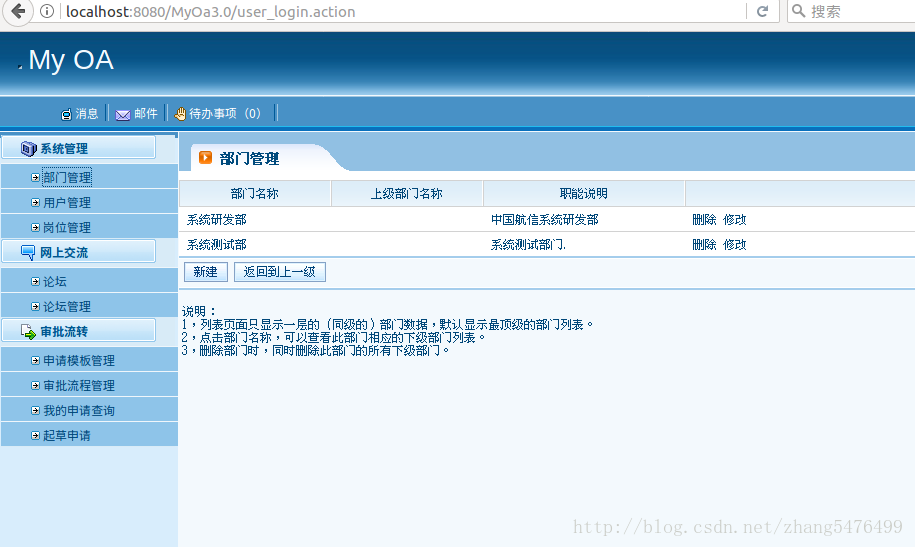您好,登錄后才能下訂單哦!
您好,登錄后才能下訂單哦!
使用Struts2攔截器如何實現一個登錄驗證功能?針對這個問題,這篇文章詳細介紹了相對應的分析和解答,希望可以幫助更多想解決這個問題的小伙伴找到更簡單易行的方法。
Struts2攔截器
Struts2攔截器的概念和Spring Mvc攔截器一樣。
1.Struts2攔截器是在訪問某個Action或Action的某個方法,字段之前或之后實施攔截,并且Struts2攔截器是可插拔的,攔截器是AOP的一種實現.
2.攔截器棧(Interceptor Stack)。Struts2攔截器棧就是將攔截器按一定的順序聯結成一條鏈。在訪問被攔截的方法或字段時,Struts2攔截器鏈中的攔截器就會按其之前定義的順序被調用。
使用攔截器的第一步:
自定義我的權限攔截器CheckPrivilegeInterceptor,這個攔截器繼承自AbstractInterceptor這個抽象類,當然你可以實現Interceptor這個接口。
import com.opensymphony.xwork2.ActionContext;
import com.opensymphony.xwork2.ActionInvocation;
import com.opensymphony.xwork2.interceptor.AbstractInterceptor;
import com.shizongger.oa.domain.User;
public class CheckPrivilegeInterceptor extends AbstractInterceptor {
@Override
public String intercept(ActionInvocation invocation) throws Exception {
System.out.println("---攔截器未攔截之前---");
String result = invocation.invoke();
System.out.println("---攔截器攔截之后---");
return result;
}
}自定義的攔截器要覆蓋AbstractInterceptor抽象類的抽象方法intercept()方法,該方法是對所有的action進行攔截,String類型的返回值是我們將要返回的視圖,如果要放行我們要攔截的action地址,那么代碼如上所示。
使用攔截器的第二步:
配置struts的配置文件,主要是配置自定義的攔截器和配置攔截器棧。在struts.xml配置文件的package元素節點下添加以下配置:
<!-- 配置攔截器 -->
<interceptors>
<!-- 聲明攔截器 -->
<interceptor name="checkPrivilege" class="com.shizongger.oa.util.CheckPrivilegeInterceptor"></interceptor>
<!-- 重新定義默認的攔截器棧 -->
<interceptor-stack name="defaultStack">
<interceptor-ref name="checkPrivilege"></interceptor-ref>
<interceptor-ref name="defaultStack"></interceptor-ref>
</interceptor-stack>
</interceptors>啟動我的Tomcat服務器,當我在瀏覽器輸入我的action地址時,都會被該攔截器的intercept攔截,默認是放行的,如果返回空字符串則因找不到對應的視圖而報錯。
登錄和權限攔截
攔截器在Web開發中應用場景最多的地方就是登錄驗證和權限驗證了。對于那些未登錄系統的用戶,一般我們都把他所有的請求打回到登錄頁面。而對于那些已經登錄系統的用戶,如果你不具有相應的權限,那么將無法訪問我們的url。
首先在監聽器中最一些系統做一些監聽任務。
public class MyServletContextListener implements ServletContextListener {
Log log = LogFactory.getLog(this.getClass());
@Autowired
private PrivilegeService privilegeService;
@Override
public void contextDestroyed(ServletContextEvent sce) {
log.debug("---銷毀監聽器---");
}
@Override
public void contextInitialized(ServletContextEvent sce) {
ServletContext sc = sce.getServletContext();
ApplicationContext ac = WebApplicationContextUtils.getWebApplicationContext(sc);
PrivilegeService privilegeService = (PrivilegeService) ac.getBean("privilegeServiceImpl");
List<Privilege> topPrivilegeList = privilegeService.findTopList();
//將權限list放到比application作用域還大的ServletContext
sc.setAttribute("topPrivilegeList", topPrivilegeList);
// 準備數據:allPrivilegeUrls
Collection<String> allPrivilegeUrls = privilegeService.getAllPrivilegeUrls();
sc.setAttribute("allPrivilegeUrls", allPrivilegeUrls);
}
}監聽器的任務是從Web容器中獲得Spring的容器ApplicationContext,再從ApplicationContext中獲得權限服務類privilegeService,這個service主要作用有兩點,其一是獲得有多的頂級權限列表;其二是獲得所以權限列表。將這兩者放入到application里邊。
接下來就可以在我們的攔截器中寫登錄攔截的邏輯代碼了。
public String intercept(ActionInvocation invocation) throws Exception {
//獲取信息,從session中取出當前登錄用戶
User user = (User) ActionContext.getContext().getSession().get("user");
String nameSpace = invocation.getProxy().getNamespace();
String actionName = invocation.getProxy().getActionName();
//對應的權限地址
String privilegeUrl = nameSpace + actionName;
//如果未登錄
if(user == null) {
//如果是去登錄的頁面和登錄請求,就放行
if("/user_login".equals(privilegeUrl)) {
return invocation.invoke();
//否則跳轉到登錄頁面
} else {
return "loginUI";
}
} else {
//如果已經登錄則判斷是否有權限
if(user.hasPrivilegeByUrl(privilegeUrl)) {
return invocation.invoke();
} else {
return "noPrivilegeError";
}
}
}處理的邏輯是,如果未登錄,則判斷是不是要去登錄,如果用戶正在登錄則放行,其他請求都要跳轉到loginUI登錄頁面。如果已經登錄,則判斷正在登錄的用戶是否具有相對應的權限。而判斷是否具有權限的方法在我的user.java里面。
/**
* 用戶實體
* @author shizongger
* @date 2017/03/24
*/
public class User {
private Log log = LogFactory.getLog(this.getClass());
private Long id;
private String loginName;
private String password;
private String name;
private String gender;
private String phoneNumber;
private String email;
private String description;
private Department department;
private Set<Role> roles;
//getter/settter方法
/**
* 判斷用戶是否用該權限
* @param privilegename 權限名稱
* @return
*/
public boolean hasPrivilegeByName(String privilegeName) {
log.debug("權限名稱:" + privilegeName);
//從本用戶中取出所有角色
for(Role role : roles) {
//從角色遍歷出所有權限
Set<Privilege> privilegeList = role.getPrivileges();
for(Privilege privilege : privilegeList) {
if(privilegeName.equals(privilege.getName())) {
log.debug(privilegeName + "---有權限---");
return true;
}
}
}
log.debug(privilegeName + "---沒有權限---");
return false;
}
/**
* 判斷本用戶是否有指定URL的權限
*
* @param privUrl
* @return
*/
public boolean hasPrivilegeByUrl(String privUrl) {
// 超級管理有所有的權限
if (isAdmin()) {
return true;
}
// >> 去掉后面的參數
int pos = privUrl.indexOf("?");
if (pos > -1) {
privUrl = privUrl.substring(0, pos);
}
// >> 去掉UI后綴
if (privUrl.endsWith("UI")) {
privUrl = privUrl.substring(0, privUrl.length() - 2);
}
// 如果本URL不需要控制,則登錄用戶就可以使用
Collection<String> allPrivilegeUrls = (Collection<String>) ActionContext.getContext().getApplication().get("allPrivilegeUrls");
if (!allPrivilegeUrls.contains(privUrl)) {
return true;
} else {
// 普通用戶要判斷是否含有這個權限
for (Role role : roles) {
for (Privilege priv : role.getPrivileges()) {
if (privUrl.equals(priv.getUrl())) {
return true;
}
}
}
return false;
}
}
/**
* 判斷本用戶是否是超級管理員
*
* @return
*/
public boolean isAdmin() {
return "admin".equals(loginName);
}
}hasPrivilegeByUrl()方法為根據url判斷用戶是否具有權限的代碼邏輯,此邏輯分為三部分。其一,如果登錄的用戶是超級管理員admin,則不用驗證權限,該用戶具有所有的權限。其二,如果登錄的用戶基本功能部分不用驗證,需要驗證的功能才需要驗證。基礎功能模塊比如首頁,退出,登錄頁面等都不要再驗證。
權限的service實現類如下:
@Service
public class PrivilegeServiceImpl extends DaoSupportImpl<Privilege> implements PrivilegeService {
@Override
@Transactional
public List<Privilege> findTopList() {
List<Privilege> topPrivletList = this.getSession()
.createQuery("FROM Privilege p WHERE p.parent IS NULL")
.list();
return topPrivletList;
}
@Override
@Transactional
public Collection<String> getAllPrivilegeUrls() {
return getSession().createQuery(//
"SELECT DISTINCT p.url FROM Privilege p WHERE p.url IS NOT NULL")//
.list();
}
}未登錄的狀態直接輸入主頁面將自動彈回登錄頁面,如圖所示

在登錄狀態下權限如圖:

關于使用Struts2攔截器如何實現一個登錄驗證功能問題的解答就分享到這里了,希望以上內容可以對大家有一定的幫助,如果你還有很多疑惑沒有解開,可以關注億速云行業資訊頻道了解更多相關知識。
免責聲明:本站發布的內容(圖片、視頻和文字)以原創、轉載和分享為主,文章觀點不代表本網站立場,如果涉及侵權請聯系站長郵箱:is@yisu.com進行舉報,并提供相關證據,一經查實,將立刻刪除涉嫌侵權內容。